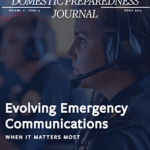As one of the largest countries in the world in terms of its land area, Canada creates a geographic challenge for emergency managers. Its ten provinces and three territories encompass dense urban areas such as the City of Toronto (nearly three million residents) and remote rural areas including many “fly-in” or “ice-road accessible” communities. Most of the population lives along the nation’s southern border, which is shared with the United States.
However, there are still thousands of municipalities, outside of this narrow ribbon of border, that range in size from less than a thousand residents – e.g., Greenwood, British Columbia – to densely populated cities such as Edmonton (capital of the Alberta Province), with a population of more than 800,000. Developing and providing effective and consistent emergency management services for all of these various communities is a difficult task.
Municipalities, Regions & Other Complexities
The complexity of Canada’s political structure creates additional challenges. In the most basic terms, the nation’s municipalities have the primary legal responsibility for emergency management. Within a region, a collection of individual municipalities work collectively to provide some common services (policing, utilities) while the individual municipality still maintains official responsibility for the town. In areas where regions are officially established, senior regional authorities are usually responsible for providing emergency social services – mass care, for example – during and after a large-scale incident, and municipal authorities are responsible for dealing with the incident itself. In other areas, regional authorities automatically step in when an incident reaches a certain level of danger.
Adding to these geographical and political difficulties is the fact that each province is governed in accordance with the responsibilities spelled out in its own Emergency Management Act. In some areas of the country, therefore, provincial authorities are engaged immediately in sudden times of crisis and have strong influence on how emergencies are managed. In other areas, though, the provinces become involved only when requested to do so by municipal or regional authorities.
In addition, the approach to the actual profession of “emergency management” differs from one province to another. In some provinces such as Ontario, each municipality is required by law to have a specific person – preferably a specialist in emergency management – designated as the Community Emergency Management Coordinator (or similar title). In other provinces, senior fire or police department officials serve as the on-scene managers and community emergency management professionals who run the emergency operations centers and are responsible for most other aspects of planning, preparation, and mitigation.
At the national level, Public Safety Canada is the Department with primary responsibility for all major emergencies throughout the country. During the past six months, the Department not only has been in transition but also has recently announced cuts in funding for: (a) the Canadian Emergency Management College, an Ottawa-based government-focused training facility that offers a broad spectrum of basic emergency management and high-level CBRN (chemical, biological, radiological, nuclear) courses; (b) the five highly trained Canadian HUSAR (Heavy Urban Search & Rescue) teams; and (c) the nation’s Joint Emergency Preparedness Program (JEPP), which was designed to help municipalities throughout the nation prepare more effectively for local responses.
It is still uncertain how, and how much, those funding reductions will affect response capabilities. Nonetheless, because the Public Safety Canada Department itself is still in a period of restructuring, the possibility of additional changes and/or budget reductions is somewhat uncertain – but would not be surprising.
Risks, Hazards & Vulnerable Populations
Another complication the nation faces is a broad range of natural hazards and sudden changes in temperature. Along the provinces and territories on its Atlantic coast, for example, the nation annually copes with a number of flooding incidents and occasional hurricanes. Major cities and most municipalities in that area also must deal with severe winter weather conditions for several months each year.
Yet another difficulty that must be taken into consideration is that tornadoes, hot and cold weather extremes, and forest fires have become increasingly more common across the nation in recent years. The potential for earthquakes in western Canada is another growing concern; British Columbia authorities are using proactive mitigation and response planning to address this latter risk. Also, because neither meteorological nor geological hazards respect man-made borders, Canadian officials must collaborate with other nations – for example, their U.S. neighbors – to develop and carry out joint response plans. British Columbia officials have made the effort to learn from the expertise of New Zealand Emergency Managers, following the multiple Christchurch earthquakes. The expertise available from other nations helps Canadians avoid insular thinking, a “We have to do it all by ourselves” mentality.
As evidenced by the more extreme temperatures and significant meteorological events that the nation has experienced in recent years, it seems clear that Canada’s climate is changing – how much, and for how long, has yet to be determined. However, in Ontario prior to 2009, to consider but one example, there had been for some time an average of 20-30 tornadoes each year – but on 20 August 2009 more than 20 tornadoes struck in a single day.
The potential for global climate change is another recent concern. Research is now underway by various emergency management students and environmental experts studying areas of drought where there was no history of it before. The potential impact on floodplains and urban development, and on animal/insect as well as human populations, caused by rising sea levels and other climate changes obviously could be calamitous. In large part for that reason, efforts are already underway to map potential climate changes in all areas of the country. The results of that effort will be used to assist municipalities across the nation in creating mitigation plans to cope with the impact of such changes.
Canadian officials also must cope with growing social and economic concerns. The nation’s aging and other vulnerable populations have for that reason been receiving additional attention over the past few years. Many provincial and municipal government agencies – e.g., Emergency Management Ontario – have developed and are already issuing preparedness materials focused on at-risk residents. The necessity of responding to large-scale incidents and events that impact the poor, the homeless, and those living on social assistance has of course added an extra complexity to emergency-response plans. In addition, protecting today’s larger community housing complexes during a fire requires greater resources than were available just a few years ago, and some additional planning as well.
Lessons Learned & Future Plans
Among the key lessons observed and hopefully learned from recent incident responses is the need for improved communications. Other lessons also were learned, though – some of them involving such intangibles as erroneous perceptions and personal ego. For example, during an apartment fire in 2011, more than 1,000 residents had to be evacuated. Many of them were not self-sufficient and/or were suffering from various health issues. Finding alternate housing was a difficult task, primarily because the City’s social housing system was already overwhelmed. Miscommunications and a degree of paranoia led to some impoverished or mentally ill evacuees having to fend for themselves. One of the most important lessons learned from this situation was the need for responders to communicate better and more effectively not only with the residents, both during and after the incident, but also with one another.
This response also clearly demonstrated the need for an ICS/IMS (Incident Command System/Incident Management System) structure to be clearly in place and respected. Having multiple Incident Commanders (ICs) – or having each city department following its own procedures without informing or consulting with the senior IC – simply does not work. In other words, there is no place for ego during an emergency response. A clear chain-of-command process must be in place beforehand – and adhered to by all responders involved.
At present, the temptation of slipping into a “nanny-state” mode in making decisions for evacuees, particularly those already vulnerable in various ways, is evident. Although well-intentioned, this mentality not only fails to build resiliency but also inhibits the regular flow of information and further increases dependence on the government. To more effectively communicate and engage residents in the decision-making process, emergency managers can and should provide the options needed to encourage greater self-sufficiency and self-determination. A small example is when faced with limited shower space within a shelter, allowing people to schedule themselves rather than being assigned a time may help to boost the self-esteem and to preserve the human dignity of all evacuees.
Canada faces many of the same challenges as other emergency managers around the world. Building and constantly improving robust first-response capabilities throughout the country and charting a rapid evolutionary path for the profession of emergency management have adequately prepared Canadian responders to cope with most day-to-day and medium-size incidents. However, that is not the case should an unpredicted high-impact event occur. In any case, much additional work is still required to, among other things:
- Determine how the response to a multi-province emergency should be structured and managed;
- Address certain previously neglected licensing issues, to ensure that medical staff and other professionals licensed in one province will be able to provide services in other jurisdictions;
- Expedite the cross-border process with the United States to build the capability needed to move emergency personnel and equipment into Canada (or vice versa) in support of an emergency on either side of the border;
- Develop the processes needed to accept (or reject) the self-deployed teams from other nations that typically can be expected to volunteer assistance during large-scale disasters; and
- Accept and report the results from financial donations received from around the world.
Despite the numerous difficulties involved, Canada’s emergency managers continue to move forward, not only embracing the “best practices” followed in other nations but also achieving numerous technological advances. Members of IAEM (the International Association of Emergency Managers) hope to soon begin professional exchanges in which emergency managers throughout North America can partner with sister communities elsewhere in the world to share their operational knowledge and experiences. This type of exchange will further expand and improve Canada’s own abilities and capabilities as well as those of all participating nations.
____________
For additional information on: Public Safety Canada, visit https://www.publicsafety.gc.ca/index-en.aspx
Emergency Management Ontario’s “Emergency Preparedness Guide for People with Disabilities/Special Needs,” visit https://www.ontario.ca/page/emergency-preparedness-guide-people-disabilities-or-special-needs

John Saunders
John Saunders is a private-sector Emergency Management Consultant in the Toronto area and the current President of IAEM-Canada. He recently finished a seven-year term as Provincial Director of Disaster Management and International Response for the Canadian Red Cross. Prior to assuming that position he was owner of Saunders Enterprises, where he provided business-continuity planning and health and safety training/consulting services. He can be reached at saunders2472@cogeco.ca or on Twitter @JohnMSaunders.
- John Saundershttps://domesticpreparedness.com/author/john-saunders






